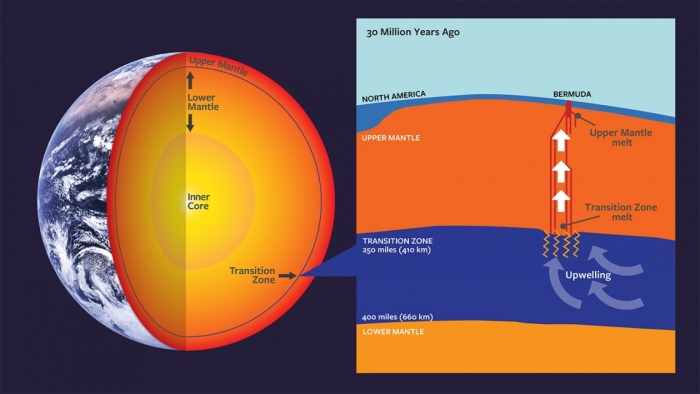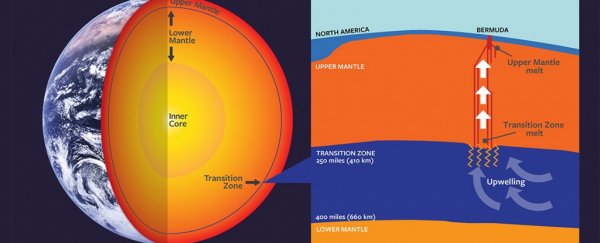Researchers have pinpointed a previously unknown source of volcanoes in the extreme depths of Earth - in the transition zone between the upper and lower mantle.
Until now, we thought we had a handle on the ways in which volcanoes form, welling up from the molten regions in the upper mantle beneath our planet's crust, but the new discovery takes things much farther down.
In the Bermuda islands, which sit atop an extinct volcanic seamount, geologists have found the first direct evidence that material from the transition zone, between 400 and 650 kilometres (250 and 400 miles) below Earth's surface, can bubble up and be spewed out of volcanoes.
"We were expecting our data to show the volcano was a mantle plume formation - an upwelling from the deeper mantle - just like it is in Hawaii," said geologist Esteban Gazel of Cornell University.
"This is the first time we found a clear indication from the transition zone deep in Earth's mantle that volcanoes can form this way."
Hawaii's volcanoes originate at depths up to between 200 and 400 kilometres (120 and 250 miles). But Bermuda's volcano is rooted much deeper, in a region rich in water, crystals and molten rock, according to the team's findings.
 (Wendy Kenigsberg/Clive Howard, Cornell University, modified from Mazza et al. 2019)
(Wendy Kenigsberg/Clive Howard, Cornell University, modified from Mazza et al. 2019)
The geologists found this evidence in a core sample drilled in Bermuda in 1972. It's over 700 metres (2,600 feet) long, and it's basically a timeline of the region's geological history. As material gets deposited, it forms a layer in the rock, and researchers are able to study these to reconstruct past events.
The researchers analysed it, looking for isotopes, trace elements, evidence of water and volatiles, expecting their results would show that the volcano was an upwelling from the upper mantle.
But they found something else: 30 million years ago, the transition zone belched, sending material through the upper mantle to the surface, where it created first the volcanic seamount, then, as it rose higher, Bermuda.
"I first suspected that Bermuda's volcanic past was special as I sampled the core and noticed the diverse textures and mineralogy preserved in the different lava flows," said geologist Sarah Mazza of the University of Münster.
"We quickly confirmed extreme enrichments in trace element compositions. It was exciting going over our first results … the mysteries of Bermuda started to unfold."
They found crystals containing larger amounts of water than can usually be found in subduction zones, the regions at the boundaries of the tectonic plates where the edge of one slides beneath the other. The assemblage of minerals found in the sample, including crystals of titanium-augite, feldspars, phlogopite, spinel, perovskite and apatite, also suggest a large amount of water.
But what really identified the source of the lava core were the lead isotopes, which were of an extreme variety never before observed in lava.
They're the most radiogenic lead isotopes that have ever been found in an ocean basin - far too radiogenic to have originated in the upper mantle. This, the researchers believe, points to a deeper origin.
Numerical modelling helped determine that the most likely scenario is a disturbance in the transition zone, which caused material to melt and percolate upward towards the surface.
It's a result that could help identify more volcanoes that may have originated in those murky depths - and help understand the geological processes that shaped our planet.
"With this work we can demonstrate that the Earth's transition zone is an extreme chemical reservoir," Gazel said. "We are now just now beginning to recognise its importance in terms of global geodynamics and even volcanism."
The research has been published in Nature.
